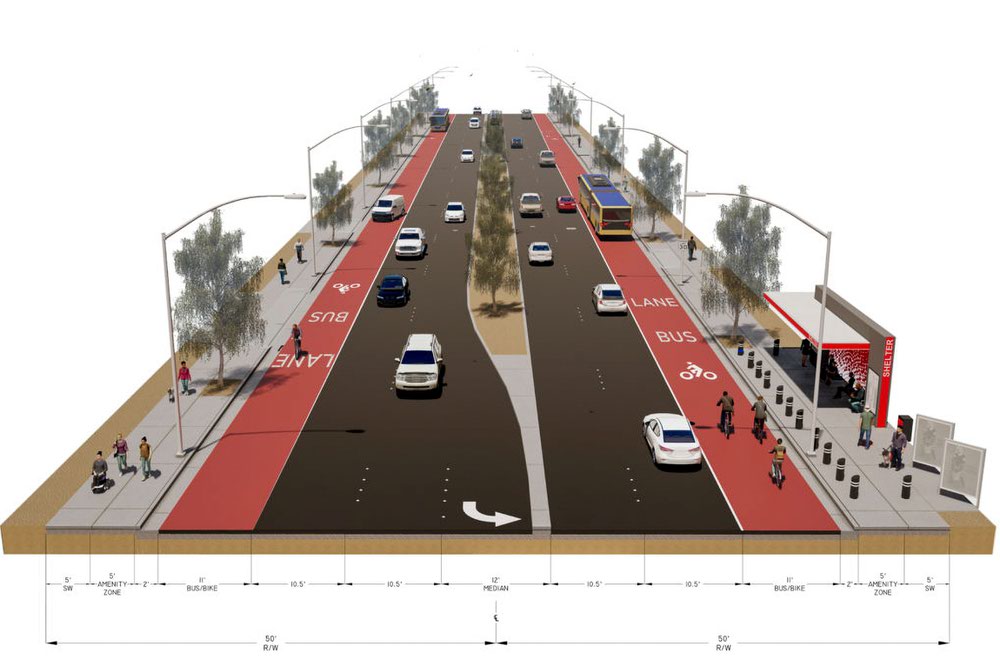Maryland Parkway is a very busy street. There’s no better way to describe this midtown thoroughfare, which connects Downtown Las Vegas directly with the airport. Along the way, it passes by several public schools, Sunrise Hospital, a dense assortment of retail stores and the main campus of UNLV. It serves some 90,000 residents, touches 80,000 jobs and accommodates 35,000 vehicles daily.
Furthermore, Maryland Parkway is where you’ll find the 109 bus, one of the busiest routes operated by the Regional Transportation Commission of Southern Nevada (RTCSNV). Thousands board the 109 daily, heading to work, school or shopping. Several years ago, RTCSNV undertook a study to determine what kind of transit would best serve this fast-growing, dense urban corridor. Light rail was seriously considered, but the funding wasn’t there to support it, so RTCSNV pivoted towards Bus Rapid Transit.
Wait, what? Though Bus Rapid Transit (BRT) is a common sight in countries around the world, and in a number of U.S. states—most notably California, Colorado and Texas—it’s not exactly a household term, and it takes some doing to unpack. Case in point: RTCSNV’s webpage on the proposed Maryland BRT route (rtcsnv.com/maryland-parkway) has a nearly 1,600-word FAQ.
Jacob Simmons, RTCSNV’s principal transit operations planner, manages to describe BRT more succinctly.
“BRT is a bus-based public transportation designed to have more capacity and higher reliability than traditional bus service,” he says. “A BRT system usually includes dedicated lanes for buses and stops or stations, traffic signal priority at least at some locations, and high frequency service. Exact system designs vary in places across the United States, but those are common features.”
Put another way: BRT, at its best, should feel something like light rail without the rails. The global nonprofit Institute for Transportation & Development Policy (ITDP) names the five essential features to make a BRT route: A dedicated right-of-way, a separated busway alignment (meaning a separated center lane, not one that sticks to the curb), pre-boarding fare collection, signal and lane controls (so that cars can’t make turns from, or across, the bus lane while a bus is present) and raised boarding platforms that eliminate the inconvenience of stepping up to board.
It’s too soon to say if the 13-mile Maryland Parkway BRT project will incorporate all these elements, Simmons says, though from the look of RTCSNV’s aspirational renderings, it’s likely to include many of them. The route begins at the South Strip Transit Terminal and ends near the recently completed UNLV School of Medicine. The renderings of Maryland as a BRT corridor depict a calmer street, with combination bus/bike lanes, larger and more aggressively shaded bus shelters, and a median planted with low-water trees, which will help to diminish the heat that builds up along the asphalt-heavy Parkway.
“BRT involves more than just running buses more frequently with fewer stops. I mean, that’s basically limited-stop, local, traditional transit service,” he says, adding that BRT brings a “more convenient, more comfortable waiting experience,” as well as improved on-time reliability. “It can also include wide sidewalks, more street trees, bike lanes—just generally enhancing the visual appeal. With that comes potential redevelopment, and a greater sense of place.”
And the coaches themselves might be more pleasant than the ones we’ve known, as RTC moves to reduce its carbon footprint. There’s a strong possibility that when Maryland’s BRT route begins operation, it’ll be serviced by electric vehicles.
“RTC has a zero-emission vehicle transition plan that we’re moving towards. … We’ve already welcomed our first 40-foot hydrogen-powered bus into the fleet,” Simmons says. “There are plans in the next few years to procure additional electric and hydrogen-powered buses. We’ll be seeing vehicles like that throughout Southern Nevada on various routes, and that would include future BRT lines.”
Work on the Maryland Parkway BRT line could begin as early as this year. The projected cost of the improvements is $334 million, 58% which will be funded through federal sources. If all goes to plan, the Maryland Parkway BRT might be up and running within two years, by which time RTCSNV will likely be well into planning the next few BRT routes. It has several options on the table, all of them corresponding with current high-ridership bus routes.
“Here in the Las Vegas Valley, we have quite a few major arterials that are also very high transit ridership corridors [and] potential candidates for BRT service,” Simmons says. “Maryland Parkway currently has over 9,000 boardings per weekday, [but] Flamingo has over 10,000 boardings per weekday, and Charleston has 9,000 to 10,000 as well.”
Cities need mass rapid transit to grow. In the steady rebuild from the Great Recession, the Las Vegas Valley has swelled to a population of nearly 2.5 million, adding several more high-traffic tourist attractions and miles of new roadway, but transit innovation here has lagged. The Las Vegas Monorail is late in its operational life and is probably too pricey to expand. The Boring Company’s network of tunnels, while novel, will be largely confined to the tourist corridor.
RTCSNV won’t begin to address all of Vegas’ rapid transit with the Maryland Parkway BRT, but it’s a start, one that could roll out relatively quickly and begin making a difference in how travelers in one densely packed part of the city get from here to there.
The BRT experience isn’t quite as novel or Instagrammable as light rail. But when done correctly, it can carry just as many passengers, and is far less expensive to maintain. It might even entice some transit-wary Las Vegans to leave their cars at home for a change.
“That’s one of the project goals,” Simmons says. “Right now, the RTC system is extremely well-utilized for the service that it is. … Just today, we’ll see 150,000 boardings throughout our entire system. But at the same time, we do recognize that a large portion of the community is not using RTC’s service and is certainly not using it on a regular basis. Part of this is about broadening that appeal and bringing on as wide an array of users as possible.”
Click HERE to subscribe for free to the Weekly Fix, the digital edition of Las Vegas Weekly! Stay up to date with the latest on Las Vegas concerts, shows, restaurants, bars and more, sent directly to your inbox!



